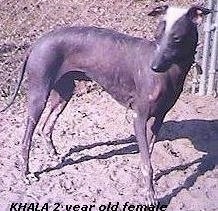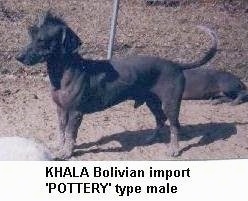
Other Names: Khala (Bolivian Quechua Indian name meaning ‘no clothing’), Hairless Khala Medio, Hairless Khala Grande, Bolivian Khala
The Bolivian Khala, also known as the Hairless Khala, is a rare and ancient dog breed originating from Bolivia, prized for its unique appearance and loyal nature. There are two main types: Khala Medio (medium-sized) and Khala Grande (larger variety). These dogs are recognized for their sleek, hairless bodies, which make them distinct among the world’s small number of hairless breeds. Their lack of fur requires specific care, such as regular moisturizing and protection from extreme temperatures, as their skin is sensitive to both sunburn and cold.
History and Origins
The Khala breed is believed to have descended from ancient breeds that once roamed the Americas. Like other hairless dogs from Central and South America, they may trace their lineage back to dogs owned by indigenous cultures, including the Incan civilization. The name “Khala” comes from the Quechua language, meaning “no clothing,” a nod to their bare skin. These dogs have been companions and guardians for centuries, particularly in high-altitude regions of Bolivia.
Physical Characteristics
Khala dogs are known for their lean and athletic build. Despite being hairless, some individuals may have tufts of hair on their heads, tails, or feet. Their skin can come in various shades, from pink to dark tones, often with patches or spots. They are medium to large-sized dogs, with Khala Grande standing up to 26 inches tall and weighing between 26-55 pounds. The Khala Medio is slightly smaller, with a more compact and manageable size, making it more suitable for families with children.

Temperament
The Khala is an affectionate and loyal breed that bonds closely with its human family. They are known to be somewhat aloof toward strangers, which makes them excellent watchdogs. Early socialization is crucial to prevent them from becoming overly wary or territorial around other pets and unfamiliar people. Despite their independent streak, Khalas are intelligent and respond well to positive training methods, making them good companions for experienced dog owners. They can adapt well to various living environments, including both rural and urban settings, provided they get regular exercise and mental stimulation.
Care Requirements
Given their hairless nature, Khala dogs need special skin care to protect them from the elements. Owners should apply sunscreen or dress them in protective clothing when outdoors to avoid sunburn. In colder weather, sweaters or jackets are recommended to keep them warm. Regular bathing is necessary to keep their skin clean and free from infections, as they lack the natural protection that fur provides. Their teeth also require special attention, as many hairless breeds, including the Khala, are prone to dental issues.
Health and Lifespan
The average lifespan of a Khala dog is 10 to 14 years, although with proper care, they can live longer. Their most common health concerns include skin allergies, dental diseases, and a genetic condition called canine ectodermal dysplasia, which affects their skin, hair, and teeth. Regular veterinary check-ups are essential to catch and manage any potential health problems early on.
The Khala is a truly unique and loyal breed, making it a cherished companion for those who can meet its care needs. With proper training, socialization, and skin care, this ancient breed can thrive in a modern household.